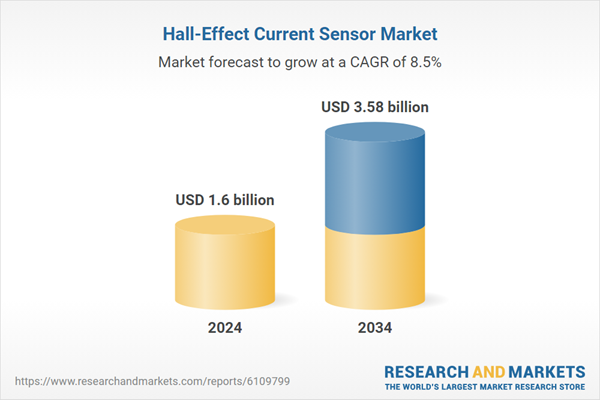The rise of compact, multifunctional consumer electronics also fuels market expansion. Devices such as smartphones, wearables, and smart home systems require miniaturized current sensors that deliver high accuracy without sacrificing space. Hall-effect sensors fit this need perfectly due to their solid-state design, low power usage, and high sensitivity. By integrating these sensors into power management circuits, manufacturers enhance device safety and efficiency through real-time current monitoring, overload protection, and energy optimization - features essential for today's smarter electronic products.
The closed-loop, or compensated, hall-effect current sensor segment is expected to grow at a CAGR of 9.6% through 2034. This category is preferred in applications demanding exceptional accuracy, rapid response, and stability, including industrial motor drives, robotic automation, rail systems, and renewable energy setups. Typically designed to measure currents between 40A and 150A, these sensors maintain excellent linearity even under temperature fluctuations, making them ideal for high-performance environments. They are crucial in high-power systems like uninterruptible power supplies, EV charging infrastructure, and energy storage inverters, where reliability and precise control are vital.
The market is segmented by current range into 100A, 100-500A, and above 500A categories. The 100A segment led the market in 2024, valued at USD 841.8 million. This range covers applications with low to medium power demands, such as power supplies, lighting systems, smaller electric vehicles, and smart appliances. Smart city initiatives involving street lighting and distributed solar power systems heavily rely on 100A sensors for real-time current monitoring and power optimization. Such sensors provide critical feedback loops that enable smart lighting functionalities like dimming, motion activation, and diagnostic reporting, which are essential as urban areas advance their infrastructure.
U.S. Hall-Effect Current Sensor Market was valued at USD 331.4 million in 2024. Growth in this region is supported by the increasing adoption of energy-efficient infrastructure fueled by federal smart city programs and green energy initiatives. The expansion of solar lighting retrofits across urban areas is creating significant demand for hall-effect current sensors used in power monitoring, fault detection, and optimizing energy use. Incentives from the U.S. Department of Energy and state-level grants continue to promote solar street lighting projects, bolstering the adoption of these sensors for performance management.
Key players in the Hall-Effect Current Sensor Industry include Melexis, Texas Instruments Incorporated, Allegro MicroSystems, Inc., LEM International SA, and Infineon Technologies AG. These companies actively compete on innovation, product reliability, and expanding their reach across emerging and established markets. To solidify their position and expand market share, leading companies in the Hall-Effect Current Sensor Market focus heavily on continuous innovation, introducing advanced sensors with improved sensitivity, miniaturization, and energy efficiency.
Strategic partnerships and collaborations with original equipment manufacturers and utility providers allow them to penetrate new sectors such as electric vehicles, renewable energy, and smart infrastructure. Expanding global footprints by investing in emerging markets where smart grid deployment and EV adoption are accelerating is another vital strategy. Companies also emphasize developing customizable solutions tailored to specific application requirements, improving customer retention.
Comprehensive Market Analysis and Forecast
- Industry trends, key growth drivers, challenges, future opportunities, and regulatory landscape
- Competitive landscape with Porter’s Five Forces and PESTEL analysis
- Market size, segmentation, and regional forecasts
- In-depth company profiles, business strategies, financial insights, and SWOT analysis
This product will be delivered within 2-4 business days.
Table of Contents
Companies Mentioned
- Allegro MicroSystems, Inc.
- Asahi Kasei Microdevices Corporation
- Infineon Technologies AG
- LEM International SA
- Littelfuse, Inc.
- Magnesensor Technology
- Melexis
- Mornsun Guangzhou Science & Technology Co., Ltd.
- ROHM Co., Ltd.
- Socan Technologies
- TAMURA Corporation
- TDK-Micronas GmbH
- Texas Instruments Incorporated
- Vishay Intertechnology, Inc.
Table Information
| Report Attribute | Details |
|---|---|
| No. of Pages | 185 |
| Published | June 2025 |
| Forecast Period | 2024 - 2034 |
| Estimated Market Value ( USD | $ 1.6 billion |
| Forecasted Market Value ( USD | $ 3.58 billion |
| Compound Annual Growth Rate | 8.5% |
| Regions Covered | Global |
| No. of Companies Mentioned | 14 |









